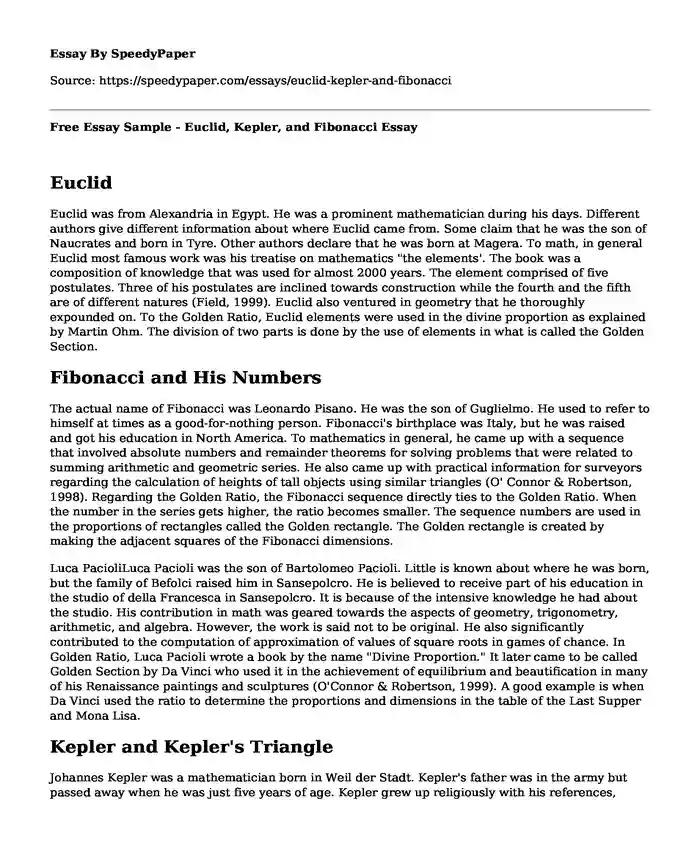
| Type of paper: | Essay |
| Categories: | Mathematics Historical & political figures |
| Pages: | 3 |
| Wordcount: | 663 words |
Euclid
Euclid was from Alexandria in Egypt. He was a prominent mathematician during his days. Different authors give different information about where Euclid came from. Some claim that he was the son of Naucrates and born in Tyre. Other authors declare that he was born at Magera. To math, in general Euclid most famous work was his treatise on mathematics "the elements'. The book was a composition of knowledge that was used for almost 2000 years. The element comprised of five postulates. Three of his postulates are inclined towards construction while the fourth and the fifth are of different natures (Field, 1999). Euclid also ventured in geometry that he thoroughly expounded on. To the Golden Ratio, Euclid elements were used in the divine proportion as explained by Martin Ohm. The division of two parts is done by the use of elements in what is called the Golden Section.
Fibonacci and His Numbers
The actual name of Fibonacci was Leonardo Pisano. He was the son of Guglielmo. He used to refer to himself at times as a good-for-nothing person. Fibonacci's birthplace was Italy, but he was raised and got his education in North America. To mathematics in general, he came up with a sequence that involved absolute numbers and remainder theorems for solving problems that were related to summing arithmetic and geometric series. He also came up with practical information for surveyors regarding the calculation of heights of tall objects using similar triangles (O' Connor & Robertson, 1998). Regarding the Golden Ratio, the Fibonacci sequence directly ties to the Golden Ratio. When the number in the series gets higher, the ratio becomes smaller. The sequence numbers are used in the proportions of rectangles called the Golden rectangle. The Golden rectangle is created by making the adjacent squares of the Fibonacci dimensions.
Luca PacioliLuca Pacioli was the son of Bartolomeo Pacioli. Little is known about where he was born, but the family of Befolci raised him in Sansepolcro. He is believed to receive part of his education in the studio of della Francesca in Sansepolcro. It is because of the intensive knowledge he had about the studio. His contribution in math was geared towards the aspects of geometry, trigonometry, arithmetic, and algebra. However, the work is said not to be original. He also significantly contributed to the computation of approximation of values of square roots in games of chance. In Golden Ratio, Luca Pacioli wrote a book by the name "Divine Proportion." It later came to be called Golden Section by Da Vinci who used it in the achievement of equilibrium and beautification in many of his Renaissance paintings and sculptures (O'Connor & Robertson, 1999). A good example is when Da Vinci used the ratio to determine the proportions and dimensions in the table of the Last Supper and Mona Lisa.
Kepler and Kepler's Triangle
Johannes Kepler was a mathematician born in Weil der Stadt. Kepler's father was in the army but passed away when he was just five years of age. Kepler grew up religiously with his references, mostly relating to God. He went to Tubingen University where he studied mathematics, Greek, and Hebrew which were necessary for him. He is remembered to have made his contribution to the discovery of the three laws of planetary motion (Field, 1999). Other works were evident in optics and the proof of working of logarithms. To the Golden Ratio, Kepler used his theories in planetary motion and astronomic to evidence that the Earth was not the center of the solar system but other planets revolved around the sun.
References
Field, J. V. (1999). Euclid of Alexandria. Retrieved from http://www-history.mcs.st-and.ac.uk/Biographies/Euclid.htmlField, J. V. (1999). Johannes Kepler. Retrieved from https://www-history.mcs.st-and.ac.uk/Biographies/Kepler.html
O'Connor, J. J., & Robertson, E. F. (1999). Luca Pacioli. Retrieved from http://www-history.mcs.st-and.ac.uk/Biographies/Pacioli.html
O' Connor, J. J., & Robertson, E. F. (1998). Leonardo Pisano Fibonacci. Retrieved from http://www-history.mcs.st-and.ac.uk/Biographies/Fibonacci.html
Cite this page
Free Essay Sample - Euclid, Kepler, and Fibonacci. (2023, Feb 09). Retrieved from https://speedypaper.com/essays/euclid-kepler-and-fibonacci
Request Removal
If you are the original author of this essay and no longer wish to have it published on the SpeedyPaper website, please click below to request its removal:
- Role of Sports on Social Mobility of the UK, Essay Example
- Free Essay on Sexual Harassment at the Work Place
- Free Essay: Case Study as a Research Method
- Free Essay on Birth Experiences of Somali Women in Canada Who Had Undergone Female Genital Mutilation
- Law Essay Example Apple's License Agreement
- Free Essay Sample: Sex Trafficking Needs Assessment
- Free Essay. The Health Belief Model Posits
Popular categories




